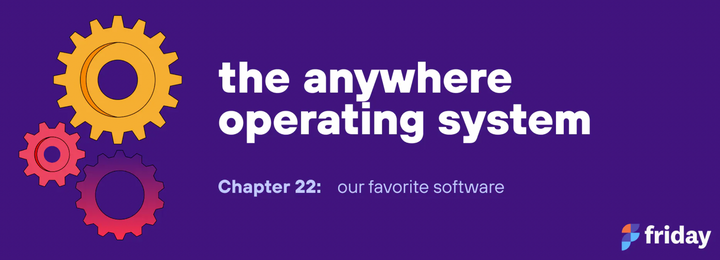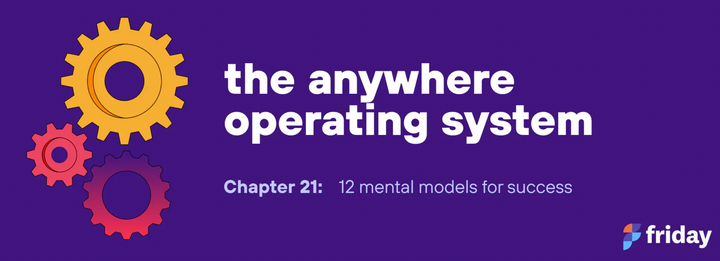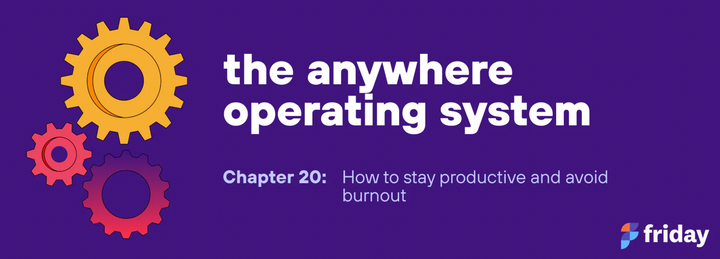Chapter 6: That meeting should have been an email
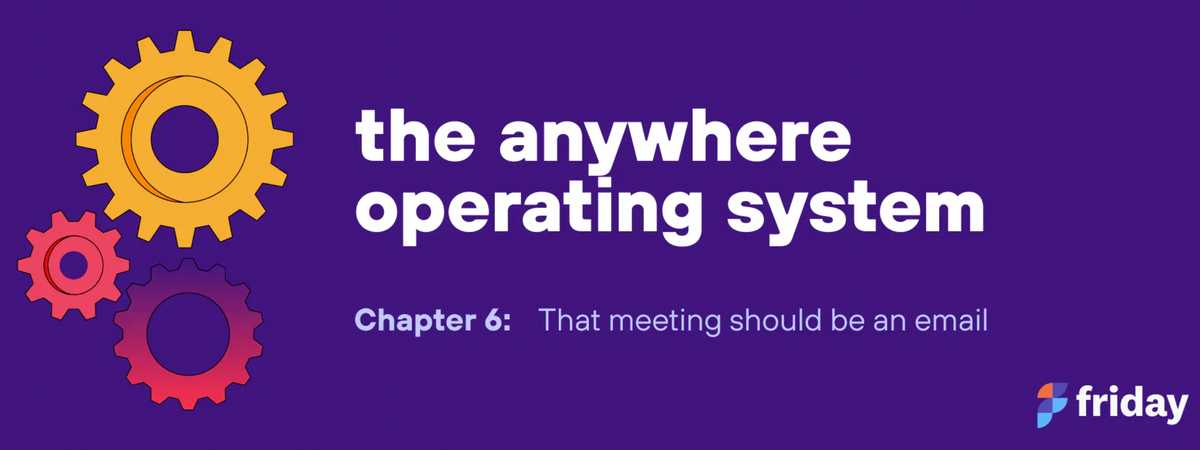
If the key to working from anywhere is to work asynchronously by default, what should we do next? When should we share a written update instead of jumping into a Zoom call? When is asynchronous communication most appropriate?
If we want to become an expert communicator, we need to know what tools we have in our toolbox and when we should use them.
Components of Communication
At a high-level, communication can be broken down into two parts: conveyance and convergence.
Huh?
Let me explain! I promise it’s worth it.
Conveyance
Conveyance is the transmission of information by the sender and the processing of that information by the recipient. If you have shared a written status update or sent an email before, you’ve conveyed information to someone else.
For the audience, the information conveyed provides useful context, but it takes time to read, watch, and interpret the message. You need time to turn the conveyed information into meaning. When your message primarily involves conveying information, you should default to asynchronous communication.
Convergence
Convergence is when two (or more) people negotiate and arrive at a shared understanding around a topic or an idea. The information shared in the conveyance step serves as the bedrock for converging and getting on the same page.
Convergence looks like it sounds. It’s when people negotiate and build a shared, collective understanding, removing ambiguity along the way. When you need to converge around a topic and build shared meaning with others, you should communicate synchronously most of the time. You need a fast feedback loop that a real-time conversation provides to get on the same page.
Relationship Strength
You also need to consider the strength of your relationship(s) with stakeholders. If you know someone well, you’ve already established mutual understanding of how each other works and you can be more casual in the way you communicate. The strength of your relationship is like oil, it makes conversations run more smoothly.
What’s your communication superpower?
Now that we understand the basic components of communication, we need to look at the communication tooling we have and learn more about their superpowers. Synchronous communication has some strengths, while asynchronous communication is more adept in other ways.
If we want to unlock new levels of productivity when working from anywhere, you need to know how to navigate back and forth between these modes of communication.
1. Asynchronous superpowers
When you compose a message asynchronously, you are unlocking specific superpowers that this form of communication enables. Asynchronous communication is:
- Revisable — you can change or edit your message to maximize clarity for the recipient
- Persists by default — your communication is automatically stored on a “hard drive” and can be referenced later, which helps reduce miscommunication
- Multi-threaded — When communicating asynchronously, it’s possible to communicate with multiple people in parallel
- More honest — when communicating behind a screen, the person composing the message is unaware of how they might be perceived because they can’t read your body language and other nonverbal cues. At times, this can lead to more unfiltered and honest communication; while, at times, it can be more composed because the person is trying to predict how you might react in advance.
- Scalable — Asynchronous communication can scale much better than real-time conversations because recipients have the ability to process the message at a time that makes sense to them. This is why you see live TV shows with millions of viewers, but a highlight clip on Youtube may have ten times the number of views.
2. Synchronous superpowers
Real-time communication has specific superpowers too, like:
- A fast feedback loop — quick, back-and-forth discussion helps you get on the same page, faster.
- More data to interpret — 80% of communication is conveyed through non-verbal cues, like tone and body language. The richness of this data can help accelerate relationship-building and make it easier to establish common ground. It’s like watching a movie in 4k instead of a black and white video from the 1930s.
- More immersive — it’s impossible to have multiple conversations at once. This forces focus, which can be useful when you need someone’s undivided attention.
How to pick the ideal communication tool?
Unfortunately, there is no right answer that works for all scenarios because each conversation is different and can evolve quickly. With that being said, the communication method you choose has an outsized impact on the way you are perceived and understood by others.
This is why you need to become an expert at picking the ideal communication method for the job at hand. Consider the following questions:
- Relationship strength — how well do I know the person?
- Clarity of conversation — how clear or unclear is the conversation?
I’ve developed a 2x2 framework to help you think through when it makes sense to communicate synchronously vs. asynchronously.
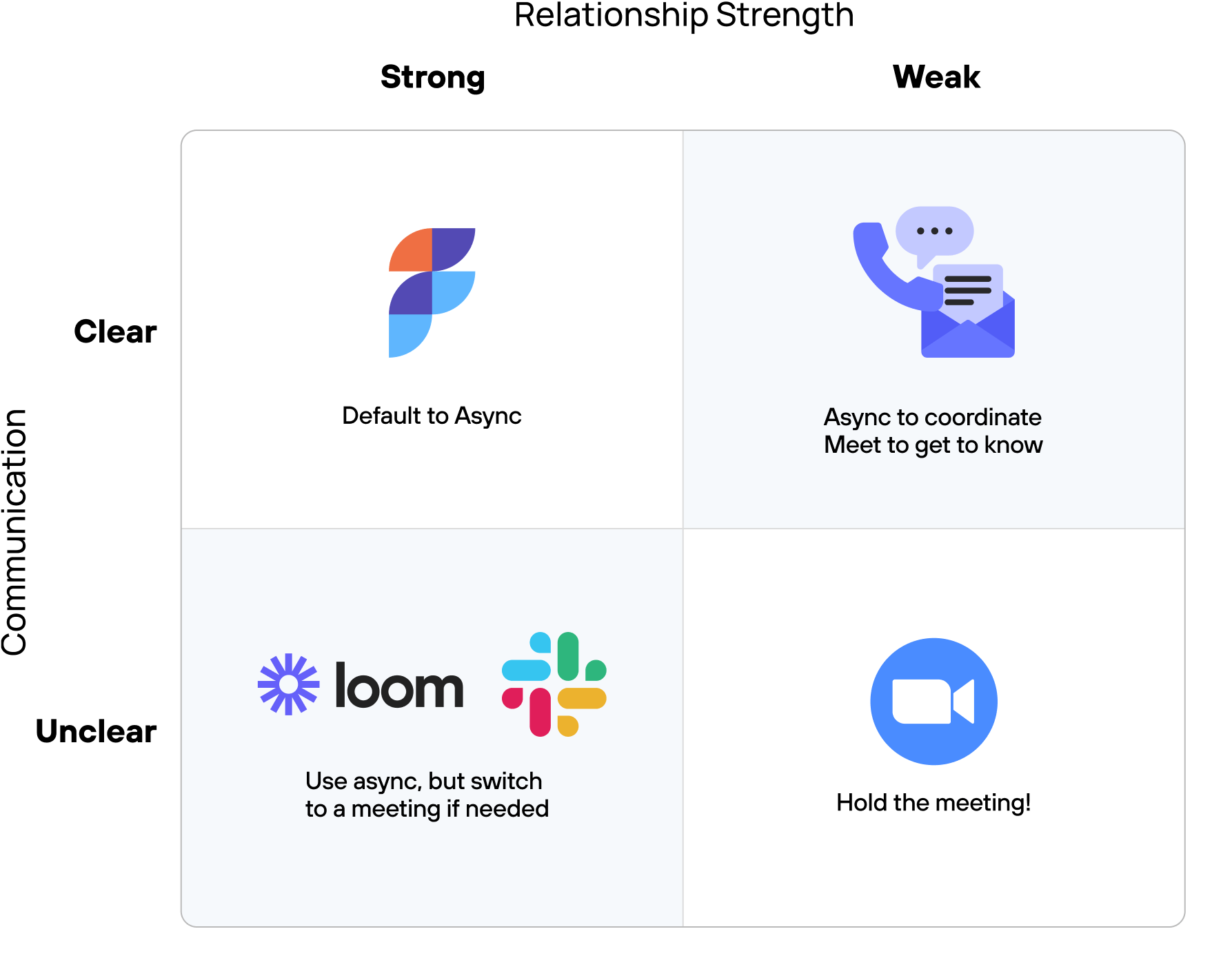
1.) Clear conversation, strong relationship
If you are working with someone you know well and are discussing a straightforward topic, you probably don’t need to have a meeting. For example, if I ask a team member to recap the week or share an update on key metrics, they could share this info over email or using a tool like Friday. If something is unclear in the update that is conveyed, we may need to converge and develop shared meaning in a meeting.
2.) Clear conversation, weak relationship
Now imagine a scenario where you are tasked with presenting a monthly update to a new client. The update is straightforward, but you also don’t know the client well. Should you schedule a real-time meeting or send the update in an email instead?
In this example, the relationship is weak, so you may want to schedule a meeting as it’s a good chance to get to know each other. It also gives you the chance to provide clarity on material you shared in the written update. Over time, as the relationship strengthens, you may not need to hold the meeting anymore.
3.) Unclear conversation, strong relationship
If you have a good relationship with the recipients, but encounter a vague topic like a strategic conversation or brainstorming session, consider syncing up in Zoom or a real-world meeting.
If you are trying to establish common ground and converge around shared meaning, you need a fast feedback loop that a real-time meeting or Slack conversation provides. With that being said, you can accelerate the conversation by sharing information asynchronously before you meet.
4.) Unclear conversation, weak relationship
In a situation where you are communicating with someone you don’t know well, on a topic that is unclear, you should meet up in person or have a Zoom call. You need to build a better relationship, create clarity, and converge around shared meaning.
These are the most complicated conversations you will have and the potential for misunderstanding is high.
For example, imagine you are exploring raising investment from a venture capital firm. You don’t know the investor well, and the nature of their involvement seems complicated. Does it make sense to email back and forth, or could the conversation be accelerated by jumping on a Zoom call?
Wrapping up
I hope this chapter provides inspiration for how you can pick the ideal communication method for the job at hand. As the communication theorist Marshall McLuhan once said, “the medium is the message.”
Want to keep reading? In the next chapter we discuss how to build asynchronous communication workflows.
